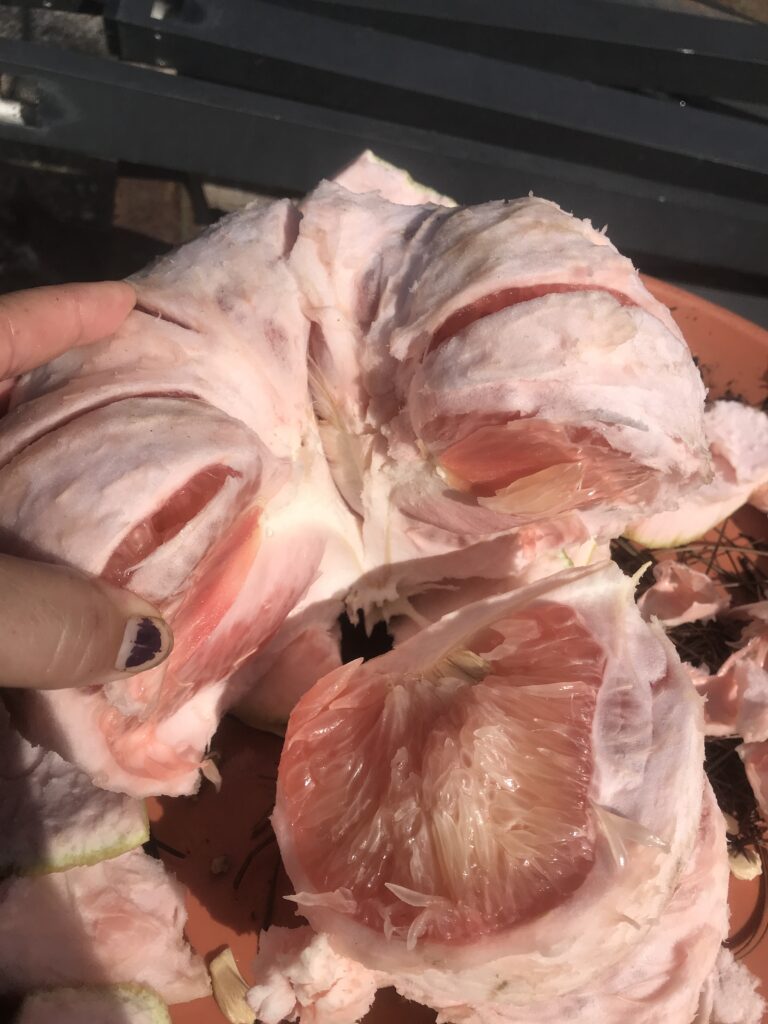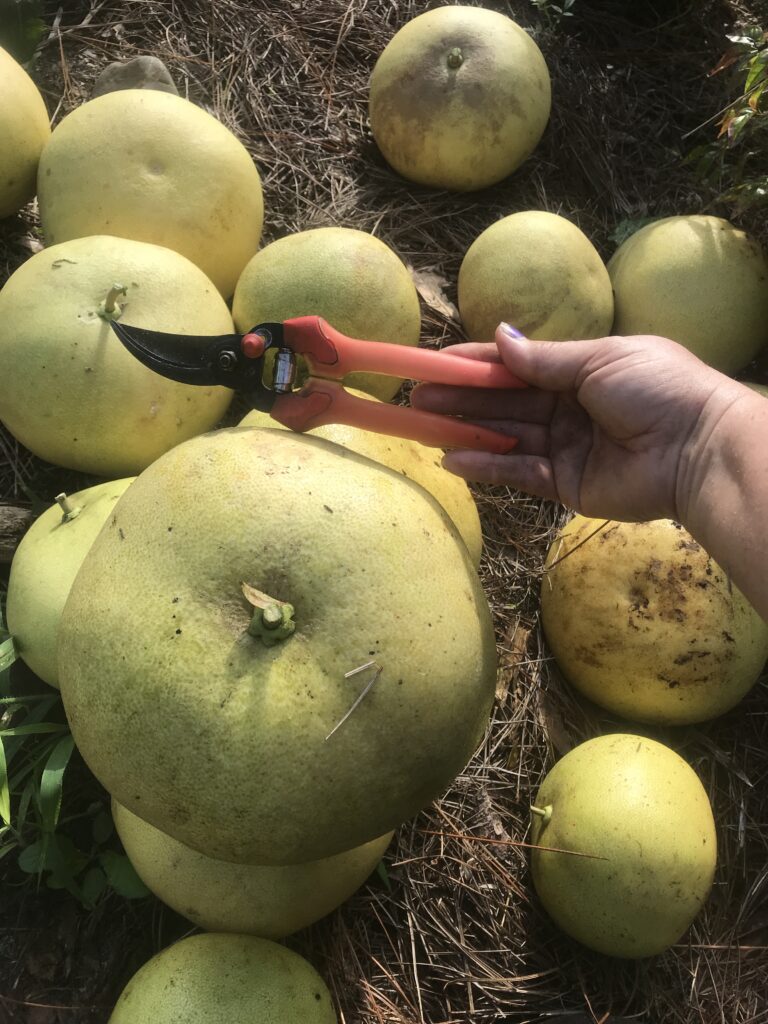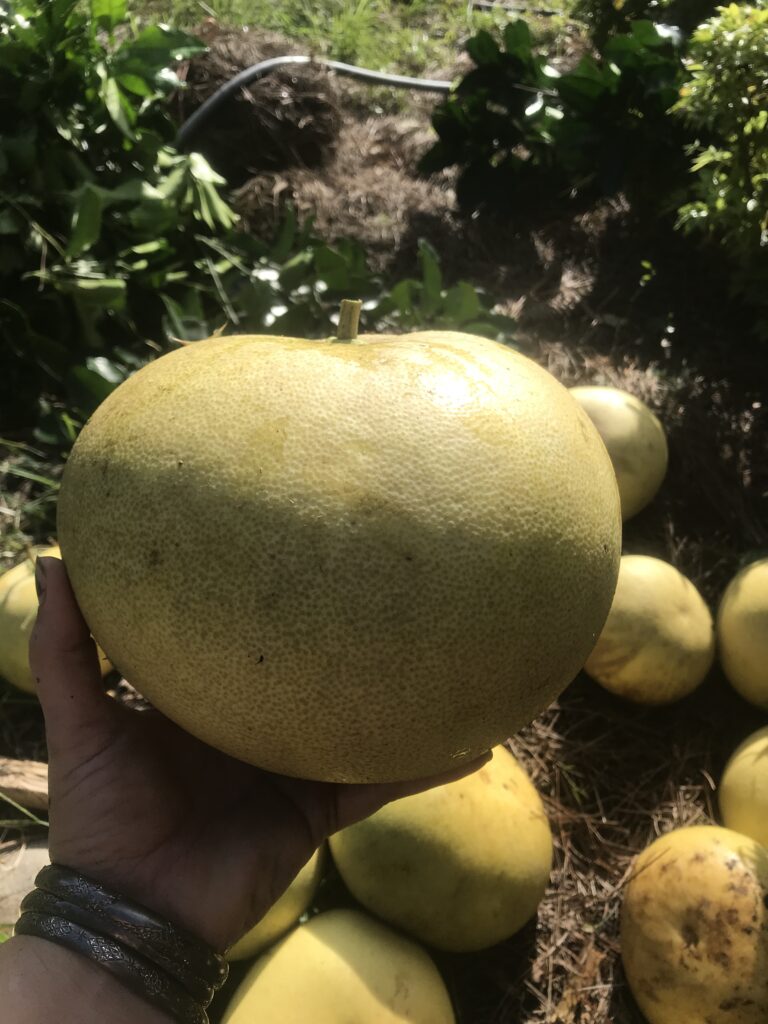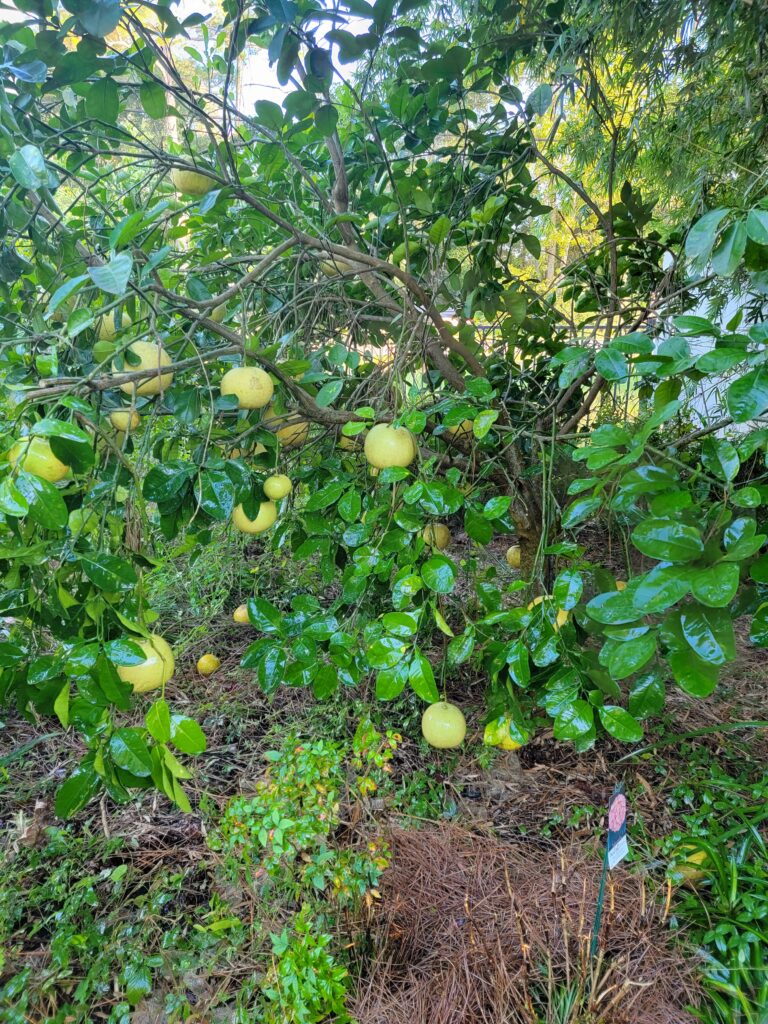Growing Pink Pummelo / Pomelo Trees in Northeast Florida Landscapes
(Citrus maxima)
Origin of Pink Pummelo / Pomelo Citrus maxima For Northeast Florida:

Pummelo are native to Maylaysia and Southeastern Asia and are the ancestors of the modern Grapefruit Citrus. They are now grown and cultivated all over the worlds subtropical and tropical areas probably the cause of the multiple spellings associated to the same fruit. Pomelo – Pummelo – Pommeloare are all variant spellings you may run across for the same fruit and are thought to originate from the Dutch “pompelmoes”, pompelmus or pampelmus in German, pamplemousse in French.
They are extremely large with the average fruit weighing around 5 lb and are heavily seeded. The flesh is sweet with no strong bitter common to grapefruit. The Pink Pummelo’s commonly grown in Florida have a thick yellow rind and pale pink flesh that, not being a grapefruit fan myself is the most delicious to me of them all. The only issue I have with this fruit is you just cant eat a whole one. A quarter of one is the equivalent of a whole grapefruit of another kind, so it takes up a bit of fridge space until its finished for me but its so worth it. For me its a 10 out of 10, would recommend!
Winter Temperature Tolerance For Pink Pummelo / Pomelo :
Pink pummelo / pomelos can be grown in zones 9-11 so they make a perfect addition to a Northeast Florida food garden.
Sun Exposure for the Pomelo \ Pummelo Tree in Northeast Florida:
Plant Pummelo trees where they will receive full sun in the Jacksonville and St. Augustine area landscapes. They require 6 hours of direct sunlight or more for best production.

Blooms and Fruit of Pomelo \ Pummelo Trees for Northeast Florida Landscape:
Blooms of the Pummelo tree are huge, thick and waxy, like other citrus they are extremely fragrant cover the plant by the thousands in the springtime!
Pummelo trees are self pollinating, so there is no need for a second tree to pollinate your tree in order for it to produce fruit.
The fruit is extremely large weighing 5 lbs on average! The common Pink Pummelo / Pomelo grown in Florida is heavily seeded with a much more mild sweet flavor than typical of more modern Grapefruit cultivars. The fruits peel starts off green and ripens to a soft buttery yellow color and the flesh is a soft pink inside. These are truly delicious and can now be found occasionally in specialty produce offerings…try one I think you might love them as much as I do!
Soil Preference for the Pomelo \ Pummelo Tree:

It is no longer a recommended practice to amend the soil in the planting hole on Citrus trees in good soil according to the University of Florida’s Institute of Food and Agricultural Sciences. However, probably due to the simple fact that old habits die hard, one UFIFAS citrus publication cautions, if you are going to amend your soil be sure to use a 50-50 ratio. In other words, use equal parts soil amendment and native soil (that is the soil you dug out of the hole before placing the tree in it), and mix the amended soil together with the native soil before back filling the hole around the tree.
Size of the Pomelo \ Pummelo Tree When Mature:
The mature size on a Pomelo \ Pummelo tree is 10-15 ft tall and 15 ft wide when grated onto trifoliate rootstock in Florida. Trees on their own roots get much larger in their native areas.
Pruning and Growth Habits of Pomelo \ Pummelo Trees for the Northeast Florida Landscape:
– Remove suckers that sprout up from the trunk, or to remove dead wood that can cause problems when left on the tree.
– When purchasing trees form and S & J Nursery container less than a 30 gallon pot size, pruning may be needed to shape the young trees into a desirable framework, and lightly pruned each year to develop the lemon trees rounded or mushroom shaped canopy.
-As the tree matures it should be shaped by selecting 3 – 5 main branches, well spaced along the trunk for fruiting production. Remove branches with narrow angles, and sub branches that are crossing or rubbing on other branches.
Planting and Mulching Tips For Pummelo / Pomelo Trees in the Jacksonville | St. Augustine area landscape:
NOTE: THIS IS IMPORTANT
-Be sure to plant into well draining soils, and keep the soil level of the dirt in the container above the soil level of the ground by 1-2 inches when you are finished planting. The soil that your tree was growing in should be slightly higher or level with the ground.
– Never bury the top of the root system ( the dirt in the pot that the tree was growing in). The soil in the top of the pot should be exposed to the air after planting, not buried by soil in any way.
Caution: Do not build berms around Citrus to hold water, as is recommended for pretty much all other trees. Leave a 12 inch diameter area around Citrus tree trunks with no mulch, do not put mulch up to the trunk of the tree on Citrus Root rot can develop quickly and good drainage is essential to a healthy tree.
Remove the grass and weeds growing under the foliage of any Citrus tree in Northeast Florida about a foot beyond where the foliage stops. Don’t allow grass and weeds to regrow under your Florida Citrus.
When planting in areas with a high water table, consider planting your Citrus into a raised berm a few feet high and 6or more ft wide. This will keep your Citrus roots up out of the water soaked ground during periods of heavy rain.
Wow, that was allot of don’ts! Here’s one last one. Don’t worry, it really isn’t as hard as it seems, once you get them going Citrus trees just keep on growing!
DO mulch under and around your citrus trees with Oak leaves, even if you have to beg some of of your neighbors. UFIFAS is recommending the practice to help deter the Asian Citrus Psyliid insect that is responsible for spreading Citrus Greening from tree to tree.
Keeping your Pummelo / Pomelo Tree Free from Pests and Diseases:

When it comes to gardening, an ounce of prevention is worth a pound of cure. That is to say that, paying attention to proper planting, watering and fertilizing practices for your citrus tree is the best way to keep it healthy and growing well.
Water Requirements of the Pomelo \ Pummelo in the Jacksonville and St. Augustine area Landscape:
Newly planted citrus trees require watering every other day for the first month and twice a week for the first few months, or in sandy soils when the top two inches of soil is dry to the touch. Take care to make sure that newly planted citrus trees receive water at least once a week for the first 2 years after being planted, skipping watering altogether once the local rain season is here.
Mature citrus trees need little to no supplemental irrigation and are more often damaged by over watering than under watering.
When citrus trees need supplemental irrigation, make sure to irrigate the soil only and not the trunk or foliage, this is best done by hand with a hose.
Fertilizing Your Pomelo \ Pummelo Tree for Northeast Florida, Jacksonville and St. Augustine area Gardens:
Citrus trees tend to be a bit demanding on the fertilizing side of the equation.
A good quality fertilizer specifically formulated for citrus trees should be used. Fertilize in spring, again in summer and, skip the fall application in Northeast Florida, and then again in January. Spread your fertilizer out into the circle of non grass area under the Canopy of your citrus tree.
Harvesting your Fresh Pomelo \ Pummelo Tree Fruits:
Pomelo \ Pummelo will be ready for harvesting fresh from your tree from December to April.

